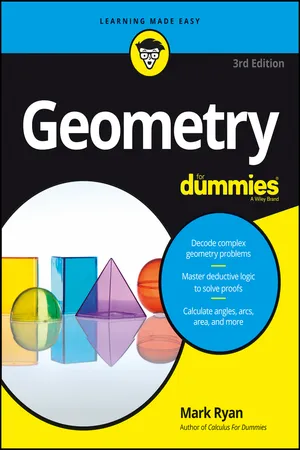Mathematics
Rhombuses
A rhombus is a type of quadrilateral with all four sides of equal length. It is also known as a diamond or a rhomb. The opposite angles of a rhombus are equal, and its diagonals bisect each other at right angles.
Written by Perlego with AI-assistance
Related key terms
6 Key excerpts on "Rhombuses"
- eBook - ePub
- Mark Ryan(Author)
- 2016(Publication Date)
- For Dummies(Publisher)
Also, note that the rhombus is vertical rather than on its side like parallelograms are usually drawn; this is the easier and better way to draw a rhombus because you can more easily see its symmetry and the fact that its diagonals are perpendicular.) Here are the properties of the rhombus, rectangle, and square. Note that because these three quadrilaterals are all parallelograms, their properties include the parallelogram properties. The rhombus has the following properties: All the properties of a parallelogram apply (the ones that matter here are parallel sides, opposite angles are congruent, and consecutive angles are supplementary). All sides are congruent by definition. The diagonals bisect the angles. The diagonals are perpendicular bisectors of each other. The rectangle has the following properties: All the properties of a parallelogram apply (the ones that matter here are parallel sides, opposite sides are congruent, and diagonals bisect each other). All angles are right angles by definition. The diagonals are congruent. The square has the following properties: All the properties of a rhombus apply (the ones that matter here are parallel sides, diagonals are perpendicular bisectors of each other, and diagonals bisect the angles). All the properties of a rectangle apply (the only one that matters here is diagonals are congruent). All sides are congruent by definition. All angles are right angles by definition. Now try working through a couple of problems: Given the rectangle as shown, find the measures of and : © John Wiley & Sons, Inc. Here’s the solution: MNPQ is a rectangle, so. Thus, because there are in a triangle, you can say the following: Now plug in 14 for all the x ’s. Angle QMP,, is, or, and because you have a rectangle, is the complement of and is therefore, or - eBook - ePub
- Sandra Rush(Author)
- 2017(Publication Date)
- Research & Education Association(Publisher)
supplementary angles.Rhombus
If we add the condition that all four sides of a parallelogram are equal, then we have a rhombus. So a rhombus has all of the properties of a parallelogram plus the sides are equal.Thus, in the above figure of the rhombus, PQ = QR = RS = SP = s, and the perimeter can be written asLikewise, the area of the rhombus iswhere any of the sides can be used as the base, and the height drawn to each side is the same. The diagonals of a rhombus bisect each other (as they did for the parallelogram), but now they also are perpendicular to each other.Rectangle
If, instead of saying the four sides of the parallelogram are equal, we say that the four angles are equal, we have a rectangle, which is a parallelogram with four equal angles.Thus, in the figure of the rectangle above, ∠T= ∠U = ∠V= ∠W, and since the angles of a quadrilateral add up to 360°, each of the four angles is 90°, or a right angle.The opposite sides are equal, as in a parallelogram, but not all sides are equal (as they were in the rhombus). The perimeter is written as usual asBecause all the angles are right angles, all sides l (length) are perpendicular to sides w (width), so they take the place of the base and height, and the area of the rectangle isHINT
If we think of tiling a floor in a straight line, we get an idea of why area is length times width. Suppose we wanted to tile a room that is 12 feet by 10 feet in 1 -foot tiles. If you count the number of tiles needed, it would be 12 rows of 10 tiles (or 10 rows of 12 tiles), and that total is 120 tiles, each 1 foot square, which is the area of the floor: 120 square feet. - eBook - ePub
- Mark Zegarelli(Author)
- 2016(Publication Date)
- For Dummies(Publisher)
right triangle has one right angle. It may be isosceles or scalene.© John Wiley & Sons, Inc.FIGURE 16-2: Types of triangles.Quadrilaterals
A quadrilateral is any shape that has four straight sides. Quadrilaterals are one of the most common shapes you see in daily life. If you doubt this statement, look around and notice that most rooms, doors, windows, and tabletops are quadrilaterals. Here I introduce you to a few common quadrilaterals (Figure 16-3 shows you what they look like):- Square: A square has four right angles and four sides of equal length; also, both pairs of opposite sides (sides directly across from each other) are parallel.
- Rectangle: Like a square, a rectangle has four right angles and two pairs of opposite sides that are parallel. Unlike the square, however, although opposite sides are equal in length, sides that share a corner — adjacent sides — may have different lengths.
- Rhombus: Imagine starting with a square and collapsing it as if its corners were hinges. This shape is called a rhombus. All four sides are equal in length, and both pairs of opposite sides are parallel.
- Parallelogram: Imagine starting with a rectangle and collapsing it as if the corners were hinges. This shape is a parallelogram — both pairs of opposite sides are equal in length, and both pairs of opposite sides are parallel.
- Trapezoid: The trapezoid ’s only important feature is that at least two opposite sides are parallel.
- Kite: A kite is a quadrilateral with two pairs of adjacent sides that are the same length.
© John Wiley & Sons, Inc.FIGURE 16-3: Common quadrilaterals.A quadrilateral can fit into more than one of these categories. For example, every parallelogram (with two sets of parallel sides) is also a trapezoid (with at least one set of parallel sides). Every rectangle and rhombus is also both a parallelogram and a trapezoid. And every square is also all five other types of quadrilaterals. In practice, however, it’s common to identify a quadrilateral as descriptively as possible — that is, use the first - eBook - ePub
Math Starters
5- to 10-Minute Activities Aligned with the Common Core Math Standards, Grades 6-12
- Judith A. Muschla, Gary R. Muschla, Erin Muschla(Authors)
- 2013(Publication Date)
- Jossey-Bass(Publisher)
A quadrilateral is any four-sided polygon. Common types of quadrilaterals are listed below:- A trapezoid is a quadrilateral that has only one pair of parallel sides.
- A parallelogram is a quadrilateral whose opposite sides are parallel and congruent.
- A rhombus is a parallelogram that has four congruent sides.
- A rectangle is a parallelogram that has four right angles.
- A square is a rectangle that has four congruent sides. A square is a rhombus that has four right angles.
Problem: Six quadrilaterals are pictured below. Choose all the names that apply to each.(1) (2) (3) (4) (5) (6) 5-76 Classifying Quadrilaterals
Because quadrilaterals can be named in many ways, they are often confused. A working knowledge of the names that apply to quadrilaterals will help to eliminate confusion.Problem: Decide whether each statement is true or false. If the statement is false, correct it.1. All squares are rectangles.2. Some rhombi are squares.3. All parallelograms are rectangles.4. Some trapezoids are parallelograms.5. All squares are rhombi.6. All rectangles are squares.5-77 Classifying Quadrilaterals in the Coordinate Plane (G-GPE.4)
You can tell a lot about a quadrilateral by looking at its graph.Problem: The coordinates of the vertices of quadrilateral are , , , and . What is the most accurate name for this quadrilateral? Support your answer.5-78 Parallelograms and Kites
A parallelogram is a quadrilateral in which both pairs of opposite sides are parallel and congruent. In the figure below, and ; and .A kite is a quadrilateral that has two pairs of congruent adjacent sides. In the example below, and .Problem: Are some parallelograms kites? Are all kites parallelograms? Write an explanation of your answers.5-79 Properties of Quadrilaterals
Parallelograms, rectangles, squares, and rhombi (the plural of rhombus) share some but not all properties.Problem - eBook - ePub
- Derek Holton(Author)
- 2009(Publication Date)
- WSPC(Publisher)
5.3. Rectangles and ParallelogramsA rectangle is a four-gon (four-sided figure) all of whose angles are right angles and whose opposite sides are equal in length.We show a rectangle in Figure 5.7 . Obviously a square is a special type of rectangle.Exercises11. Do rectangles tessellate the plane? 12. Did Escher ever start one of his “tessellations” from rectangles? 13. Are rectangles self-replicating? 14. Is every shape that tessellates the plane a self-replicating shape? 15. Can you square a rectangle (i) with squares of equal size; (ii) with squares of unequal size; (iii) with squares which are all of different sizes;(iv) with m squares;(v) with one square each of side length 1,2,…, n? 16. Divide a rectangle of side lengths 6 and 9 into squares of side length one. How many squares are there?Generalise. 17. Can you rectangle a rectangle? That is, can you make up a rectangle from smaller rectangles? In what different ways can this be done? 18. Take any two rectangles and plonk them down anywhere in the plane. In how many different shapes will the two rectangles intersect?So now we get to parallelograms. A parallelogram is a gram made of parallels. Take two pairs of parallel lines. The four-sided figure (“gram”) they make is a parallelogram (see Figure 5.8 ). So a parallelogram is a foursided figure with both pairs of opposite sides parallel.Figure 5.8.We represent the parallel property by the insertion of arrows. Because the top and bottom sides of the parallelogram in Figure 5.8 are parallel we put an arrow on each of them. Because the left and right sides of the parallelogram are parallel (but not parallel to the top and bottom sides) we put two arrows on each of them.In general the angles between adjacent sides of a parallelogram are not equal. However, when they are we get a rectangle or a square. Squares and rectangles are just special parallelograms.Exercise19. Repeat Exercises 11-18 with the words “rectangle” and “square” replaced everywhere by “parallelogram”. - eBook - ePub
- Gary Thorne(Author)
- 2015(Publication Date)
- Crowood(Publisher)
To construct a square using a compass, draw the base of AB of the required square. Erect the perpendiculars at A and B, then placing the compass on A, establish AB and draw a quarter arc to intersect the perpendicular at D. In order to confirm correct intersections, place the compass on B, using the established length AB, plot a quarter arc to intersect the perpendicular at C (not shown).A rectangle is a four-sided figure with equal opposite sides and its angles all right angles. Opposite sides and all angles being equal; diagonals from the corners are equal yet where they intersect the angles are not 90 degrees.A quadrilateral form is bound by four straight lines; when opposite sides are parallel it is a parallelogram. A quadrilateral can be a:1. Rectangle: all angles are at right angles. 2. Square: if the sides are equal. 3. Rhombus: if all sides are equal yet angles are not right angles. 4. Trapezium: only two of the sides are parallel. Quadrilaterals and polygons.PolygonsPolygons are plane figures consisting of more than four sides. When sides are equal they are called regular polygons. Polygons include:
QUADRANTS AND CIRCLES5. Pentagon: five sides 6. Hexagon: six sides 7. Heptagon: seven sides 8. Octagon: eight sides. The quadrant is a segment of a circle with a right angle at centre of the curve. The half circle has the radius of the circle forming the diameter line. The circle has a centre point. Radials can be drawn from the right angle point of a quadrant at degrees of 15, 30, 45, 60, 75 and 90 to form a quarter circle. This is established through using 45 degree and 30/60 degree set squares and a T-square.A quadrant, half circle and circle.ANGLES An acute angle is less than a 90 degree angle. An obtuse angle is greater than 90 degrees. It must be less than 180 degrees.A quadrant.The supplement of an angle is the remaining degrees which when added equals 180 degrees. ABC (overleaf) is 110 degrees. Therefore the supplement to this angle is 70 degrees. The complement of an angle is the remaining degrees which when added together form 90 degrees. 70 degrees and 20 degrees = 90 degrees.
Index pages curate the most relevant extracts from our library of academic textbooks. They’ve been created using an in-house natural language model (NLM), each adding context and meaning to key research topics.





